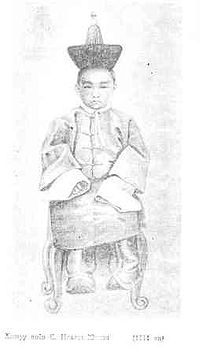- Mongolian nobility
-
The Mongolian nobility (Mongolian: язгууртан yazgurtan; Mongolian: сурвалжтан survaljtan) arose in the 10-12th centuries, became prominent in the 13th century, and essentially governed Mongolia until the early 20th century.
The Mongolian word for nobility, Yazgurtan, derives from the Mongol word yazgur, meaning the Root.
Contents
Mongol Empire
Nobility titles
- Ihe Khaan (Khagan) - Great Khaan, Emperor
- Guo Wang - State Wang, the second title after the Great Khaan. Muhulai (Muqali) of Jalair was appointed the Guo Wang.
- Jinong - Prince Royal, nominated to succeed the Great Khaan. During Yuan Dynasty, the Jinong resided in Karakorum and administered Mongolia Proper
 A Mongol ruler on his way through the country. Illustration of Rashid al-Din's Jami' al-tawarikh.
A Mongol ruler on his way through the country. Illustration of Rashid al-Din's Jami' al-tawarikh.
- Taiji - Prince
Military ranks
- Tumetu-iin Noyan - Lord of 10,000 warriors. There were 9 Tumens in 1206. By 1368 there were 40 Mongol Tumens and 4 Oirat Tumens
- Minggan-u Noyan - Lord of 1,000 warriors
- Jagutu-iin Darga - Commander of 100 warriors
- Arban-u Darga - Commander of 10 warriors
- Cherbi - Head of the Kheshig
Female titles
- Khatun - queen and ladies
- Gongzhu - princess, daughter of a noble family
- Behi - lady
Northern Yuan period
Nobility titles
- Khaan (Khagan) - ruler of the country.
- Khan - by the mid-16th century, there would be a number of khans in Mongolia as local feudal lords claimed the title for themselves. Khaan and Khan were 2 different titles: Khaan (long "a") and Khan (short "a"). Khaan was the title of the ruler of the country, while the local feudal lords had the title Khan.
- Jinong - Prince Royal, nominated to succeed the Great Khaan. Resided in the Right Wings (modern Inner Mongolia). From the 15th century, the title became hereditary and not necessarily preserved to the nominee of the Khaan's heir
- Hongtaiji - a descendant of Genghis Khaan with a fief or a prince (Huang Taizi)
- Taiji - Descendants of Genghis Khan
- Wang - a descendant of Hasar and other brothers of Genghis Khaan with a fief
- Taishi - a noble of a non-Borjigin clan with a fief such as descendants of the Tumetu-iin Noyans or a non-Borjigin chieftain
Female titles
- Taihu - queen, spouse of the Khaan
- Khatun - queen and ladies
- Gongzhu - princess, daughter of a noble family
- Behichi (Beiji) - lady, spouse of a prince
Non-gentry estates
- Sain humun - lit. good man, a rich person
- Dund humun - lit. middle man
- Magu humun - lit. bad man, a poor person
- Hitad humun - lit. Chinese man, a slave
Qing period and Boghda Khaan Mongolia
 A Khalkha Mongolian noblewoman (c.1908).
A Khalkha Mongolian noblewoman (c.1908).
Nobility titles
- Khan (not Khaan or Khagan) - Lord of a hoshun. There were 4 Khans in Khalha: Tushietu Khan, Zasagtu Khan, Secen Khan and Sain Noyan Khan, and 2 Khans in Kobdo Region: Tögs Hülüg Dalai Khan and Ünen Zorigtu Khan. They were khan rather than khaan. Despite the association of the 4 aimags with these titles, their power was restricted to their hoshuns only. They would communicate with the Manchu court just as any other Lord of a hoshun.
- Chin Wang - Lord of a hoshun. Some Wangs were ranked as Hoshoi Chin Wang - "Chin Wang twice". Annual income 2500 lang silver and 40 silk roll. 60 serfs.
- Giyün Wang - Lord of a hoshun. Annual income 1200-2000 lang silver and 15-25 silk roll. 50 serfs.
- Beile - Lord of a hoshun. Annual income 600 lang silver and 13 silk roll. 40 serfs.
- Beise - Lord of a hoshun. Annual income 500 lang silver and 10 silk roll.
- Tushiye Gong - Lord of a hoshun. Annual income 300 lang silver and 9 silk roll.
- Tusalagchi Gong - Lord of a hoshun. Annual income 200 lang silver and 7 silk roll.
The above titles would be decorated with styles.
- Hohi Taiji - Untitled Gentry. There were 4 ranks:
- Terigun Zereg-un Taiji - Gentry of the 1st rank could also be granted a hereditary lordship over a hoshun. Annual income 100 lang silver and 4 silk roll.
- Ded Zereg-un Taiji - Gentry of the 2nd rank could also be granted a hereditary lordship over a hoshun. Annual income 90 lang silver and 3 silk roll.
- Gutagaar Zereg-un Taiji - Gentry of the 3rd rank. Annual income ... lang silver and ... silk roll.
- Dötugeer Zereg-un Taiji - Gentry of the 4th rank. Annual income 40 lang silver only. 4 serfs.
Besides the above ranking, the nobles were also divided into 2 types:
- Töröl Taiji (literally, "related nobles") - members of 'Altan Urug', who are descendants of Genghis Khaan.
- Khariyatu Taiji (literally, "subject nobles") - descendants of Khasar, Belgutei and other brothers of Genghis Khaan, descendants of Tooril Khan of Kereit, descendants of Tumetu-iin Noyans.
- Age - son born to a noble family.
- Tabunang - son-in-law of a noble family.
Non-gentry estates
- Soumon Albatu - state serf
- Hamjilga - serf of a nobleman
- Shabi - serf of a Hutuhtu, of an incarnation of a Buddhist deity
See also
Categories:- History of Mongolia
- Mongolian society
- Asian nobility
- Mongolia stubs
Wikimedia Foundation. 2010.

